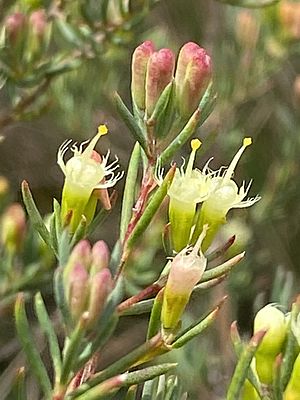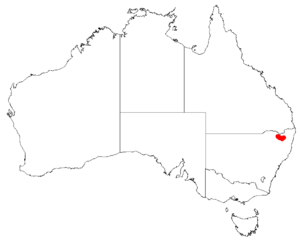Homoranthus biflorus facts for kids
Quick facts for kids Homoranthus biflorus |
|
|---|---|
 |
|
| Scientific classification | |
| Genus: |
Homoranthus
|
| Species: |
biflorus
|
 |
|
| Occurrence data from AVH | |
Homoranthus biflorus is a special plant that belongs to the myrtle family. It only grows in a small part of northern New South Wales, Australia. This plant is a shrub that stands upright. It has leaves shaped like cylinders and usually yellow flowers that grow in small groups.
Contents
What Homoranthus biflorus Looks Like
Homoranthus biflorus is a shrub that grows straight up. It can reach a height of about 1.2 meters (4 feet). Its leaves are smooth and shaped like thin cylinders. They have a pointed end. These leaves are very thin, less than 1 millimeter thick.
The flowers grow alone or in pairs. They can be red, yellow, or greenish-yellow. Each flower has petals about 2 millimeters long. These petals surround the base of a long part called a style, which is 6 to 10 millimeters long. This plant can flower and produce fruit all year. However, it mostly does so between October and January.
How Homoranthus biflorus Got Its Name
The plant Homoranthus biflorus was first officially described in 1991. Two scientists, Lyndley Craven and S.R.Jones, wrote its description. They published their findings in a science journal called Australian Systematic Botany.
Where Homoranthus biflorus Lives
This type of homoranthus plant grows in specific areas. You can find it in heathlands and woodlands. It prefers to grow on volcanic ridges. These areas are located in the Northern Tablelands region of New South Wales.
Protecting Homoranthus biflorus
Even though this plant is common in its local areas, it only grows in a few places. In 1996, scientists Barbara Briggs and John Leigh gave this species a special conservation code. This code helps show how important it is to protect the plant. Some of these plants grow near Pindarri Dam. These specific plants are not in protected areas. This means they need more attention to ensure their safety.

